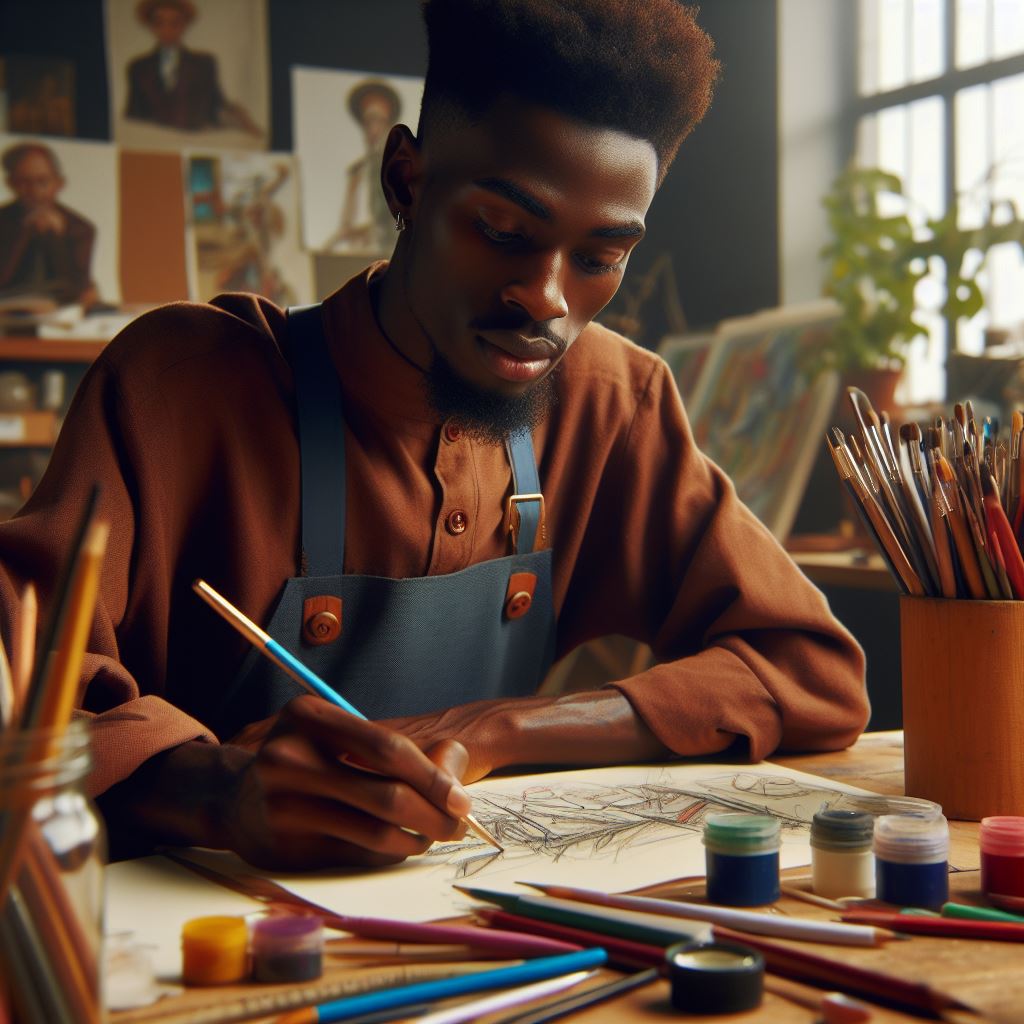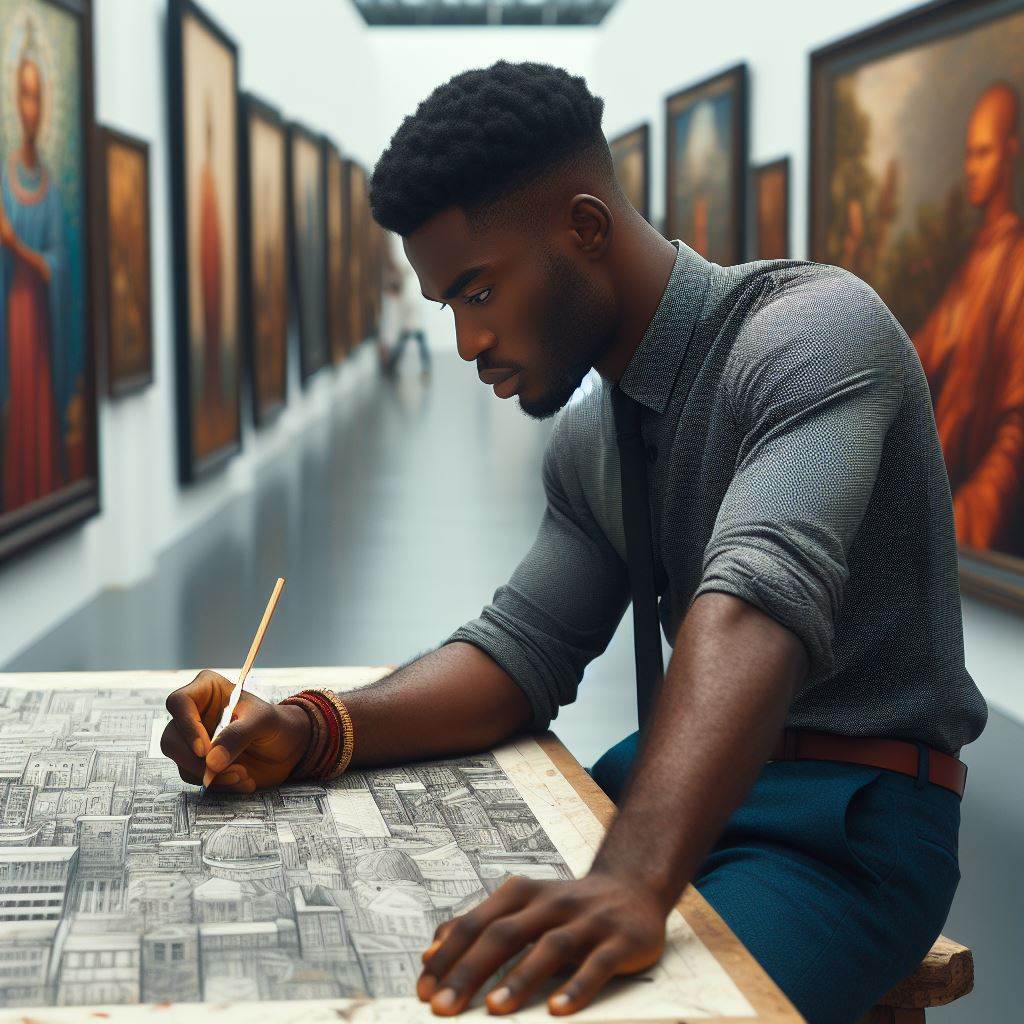Introduction
Nigeria boasts a rich artistic heritage that spans centuries. This vibrant culture includes traditional crafts, music, dance, and visual arts.
Overview of Nigeria’s Artistic Heritage
- Traditional Crafts: Nigerian artisans excel in weaving, pottery, and beadwork.
- Music and Dance: Diverse ethnic groups contribute to Nigeria’s dynamic musical and dance traditions.
- Visual Arts: Nigerian artists create stunning sculptures, paintings, and textiles.
Importance of Exploring and Preserving This Heritage
Exploring Nigeria’s artistic heritage deepens cultural understanding and appreciation. Preserving this heritage ensures future generations experience Nigeria’s rich cultural legacy.
Nigeria’s artistic heritage reflects its diverse culture and history. By exploring and preserving it, we honor and celebrate Nigeria’s vibrant traditions.
Exploring Nigeria’s Rich Artistic Heritage
Nigeria boasts a rich artistic heritage that reflects its diverse cultures and histories. Exploring and preserving this heritage is essential for cultural identity and pride.
Overview of Nigeria’s Rich Artistic Heritage
Traditional Art Forms
Nigeria’s traditional art forms include intricate wood carvings, pottery, textiles, and beadwork. These crafts have been passed down through generations.
Ancient Sculptures
Nigeria is renowned for its ancient sculptures. The Nok, Ife, and Benin civilizations produced remarkable terracotta, bronze, and ivory sculptures.
Contemporary Art Scene
Nigeria’s contemporary art scene is vibrant and dynamic. Modern artists blend traditional themes with contemporary techniques, creating unique and compelling works.
Performing Arts
Nigeria’s performing arts are rich and varied. Traditional dance, music, and theater play a significant role in cultural celebrations and rituals.
Literary Contributions
Nigerian literature is globally acclaimed. Writers like Chinua Achebe and Wole Soyinka have made significant contributions to world literature.
Importance of Exploring Nigeria’s Artistic Heritage
Cultural Identity
Exploring artistic heritage strengthens cultural identity. It connects people to their roots and fosters a sense of belonging and pride.
Historical Understanding
Art provides valuable insights into Nigeria’s history. Ancient sculptures and crafts reveal stories of past civilizations and their way of life.
Preservation of Traditions
Preserving artistic heritage ensures that traditional crafts and techniques are not lost. It helps maintain the cultural continuity of future generations.
Economic Opportunities
Nigeria’s art can boost the economy. Art tourism, galleries, and cultural festivals attract visitors and create job opportunities.
Education and Inspiration
Art education inspires creativity and critical thinking. Learning about Nigeria’s artistic heritage enriches students’ understanding of their culture and history.
Strategies for Preserving Nigeria’s Artistic Heritage
Establishing Museums and Galleries
Creating more museums and galleries helps preserve and showcase Nigeria’s art. These institutions serve as cultural repositories and educational centers.
Supporting Local Artisans
Supporting local artisans ensures the survival of traditional crafts. Government and private sector initiatives can provide training and financial assistance.
Promoting Art Education
Incorporating art education in school curriculums is vital. Teaching students about their artistic heritage fosters appreciation and creativity.
Encouraging Cultural Festivals
Organizing cultural festivals celebrates Nigeria’s artistic heritage. These events provide platforms for artists to display their work and share their culture.
Digital Preservation
Digital archiving of art can protect Nigeria’s heritage from physical degradation. Online platforms can make art accessible to a global audience.
Nigeria’s rich artistic heritage is a testament to its diverse cultures and histories. Exploring and preserving this heritage is crucial for maintaining cultural identity, understanding history, and fostering economic growth.
By establishing museums, supporting local artisans, promoting art education, encouraging cultural festivals, and embracing digital preservation, Nigeria can ensure that its artistic legacy endures for future generations.
This collective effort will keep Nigeria’s vibrant cultural tapestry alive and thriving.
Traditional Nigerian Art
When it comes to traditional Nigerian art, the country boasts a rich and diverse heritage that reflects its cultural tapestry.
Overview of Traditional Nigerian Art Forms
- Pottery: Nigerian pottery is known for its intricate designs and vibrant colors, showcasing the skills of local artisans.
- Textiles: Nigerian textiles are renowned for their bold patterns and intricate weaving techniques that have been passed down through generations.
- Woodcarving: Woodcarving in Nigeria is a centuries-old tradition that produces stunning sculptures and masks, often used in rituals and ceremonies.
History and Significance of Traditional Nigerian Art
The history of traditional Nigerian art dates back thousands of years, with artifacts found in archaeological sites across the country.
These art forms hold significant cultural and spiritual importance in Nigerian society, serving as a way to preserve and pass down traditions from one generation to the next.
Traditional Nigerian art is not only aesthetically pleasing but also serves as a means of communication, storytelling, and community bonding.
Artisans and craftsmen play a vital role in the preservation and promotion of traditional Nigerian art, keeping these ancient techniques alive and relevant in a modern world.
Through their intricate craftsmanship and dedication to their craft, these artists ensure that Nigeria’s rich artistic heritage continues to thrive and inspire future generations.
Read: Cultural Exchange Between Nigeria and China
Contemporary Nigerian Art
Modern Nigerian artists are making waves in the art world with their innovative and dynamic works. These artists are pushing boundaries and redefining what it means to be an artist in today’s globalized world.
Exploration of traditional art forms
Contemporary Nigerian art is deeply rooted in traditional art forms that have been passed down through generations. Artists today are taking inspiration from these traditional practices and reinterpreting them in new and exciting ways.
Influence of traditional art on contemporary Nigerian art
Traditional art forms such as beadwork, pottery, and wood carving continue to influence contemporary Nigerian art. Artists are incorporating elements of these traditions into their work, creating a unique fusion of old and new.
Themes and motifs in contemporary Nigerian art
Themes of identity, politics, and social issues are prevalent in contemporary Nigerian art. Artists are using their work to explore and challenge the status quo, sparking important conversations about Nigeria’s past, present, and future.
Mediums and techniques in contemporary Nigerian art
Contemporary Nigerian artists are known for their experimentation with different mediums and techniques. From painting and sculpture to installation and performance art, these artists are constantly pushing the boundaries of what is possible in the art world.
Notable contemporary Nigerian artists
Some of the most notable contemporary Nigerian artists include El Anatsui, Njideka Akunyili Crosby, and Victor Ehikhamenor. These artists have gained international acclaim for their innovative and thought-provoking works, showcasing the diversity and talent of the Nigerian art scene.
Global impact of contemporary Nigerian art
Contemporary Nigerian art is gaining recognition on the global stage, with exhibitions and collaborations happening around the world.
Nigerian artists are using their work to challenge stereotypes and misconceptions about African art, showcasing the richness and diversity of the nation’s artistic heritage.
Read: Research Areas in African and Asian Studies
Art Galleries and Museums in Nigeria
Nigeria is home to a vibrant art scene, with numerous galleries and museums that showcase the country’s rich artistic heritage. These institutions not only preserve Nigeria’s cultural legacy but also serve as platforms for contemporary artists to exhibit their work.
Overview of Notable Art Galleries and Museums in Nigeria
- National Museum, Lagos: This museum is one of the oldest in Nigeria and houses a diverse collection of Nigerian art, artifacts, and archaeological finds.
- National Gallery of Art, Abuja: This gallery focuses on promoting and preserving contemporary Nigerian art, with a strong emphasis on supporting emerging artists.
- Terra Kulture, Lagos: A popular cultural center that features an art gallery, bookstore, restaurant, and theater, showcasing Nigerian art and culture.
- Nike Art Gallery, Lagos: Founded by renowned artist Nike Davies-Okundaye, this gallery is known for its extensive collection of traditional and contemporary Nigerian art.
- Rele Gallery, Lagos: A contemporary art space that showcases cutting-edge works by emerging and established Nigerian artists, with a focus on diversity and inclusivity.
Description of Collections and Exhibitions Showcasing Nigeria’s Artistic Heritage
The collections and exhibitions in Nigeria’s art galleries and museums are as diverse as the country itself, reflecting its rich cultural tapestry and artistic traditions.
- National Museum, Lagos: The museum’s collection includes traditional Nigerian art forms such as wood carvings, textiles, pottery, and masks, as well as archaeological artifacts dating back thousands of years.
- National Gallery of Art, Abuja: This gallery regularly hosts exhibitions that explore themes related to Nigerian identity, history, and social issues, providing a platform for artists to engage with contemporary issues.
- Terra Kulture, Lagos: The art gallery at Terra Kulture features a diverse range of artworks in various media, including paintings, sculptures, and mixed-media installations, that celebrate Nigerian culture and creativity.
- Rele Gallery, Lagos: Known for its innovative programming, Rele Gallery showcases a wide range of artistic expressions, from painting and sculpture to new media and performance art, challenging traditional notions of Nigerian art.
Essentially, Nigeria’s art galleries and museums play a crucial role in preserving and promoting the country’s artistic heritage.
They serve as vital hubs for cultural exchange, dialogue, and creativity, providing a platform for artists to share their stories and visions with the world.
Transform Your Career with Expert Guidance
Get personalized mentorship consulting that’s tailored to your unique path. Our expert advice is actionable and exclusive.
Get StartedRead: How to Open a Beauty Salon in Nigeria: Step-by-Step
Find Out More: Role of Mass Communication in Nigerian Politics
Explore Further: Exploring Nigeria’s Rich Art History and Heritage
Delve into the Subject: Film Production Internships and Opportunities in Nigeria
Cultural Festivals and Events
Nigeria is a country rich in cultural diversity, and this is evident in the numerous cultural festivals and events that are celebrated throughout the country. These events play a crucial role in promoting and preserving Nigeria’s artistic heritage.
Highlighting Cultural Festivals and Events
- Osun-Osogbo Festival: This annual event takes place in Osun State and celebrates the river goddess Osun.
- Lagos Theatre Festival: Showcasing the best of Nigerian theatre, this event attracts both local and international artists.
- Calabar Carnival: Known as Africa’s biggest street party, this carnival in Cross River State is a colorful celebration of culture.
- Argungu Fishing Festival: Held in Kebbi State, this festival attracts participants from all over the world to compete in fishing competitions.
- Eyo Festival: Also known as the Adamu Orisha Play, this event in Lagos showcases traditional Yoruba culture and masquerades.
Importance of These Events
These cultural festivals and events are essential in promoting and preserving Nigerian art and culture for several reasons:
- Cultural Preservation: By celebrating these festivals, Nigerians are able to keep their traditional customs and values alive.
- Tourism and Economy: These events attract tourists and boost the local economy through increased spending and tourism-related activities.
- Community Unity: Festivals bring communities together, fostering a sense of unity and pride in their shared cultural heritage.
- Artistic Expression: Artists and performers have a platform to showcase their talents and creativity to a wider audience.
- Education and Awareness: Through these events, people learn more about Nigerian art, culture, and traditions, promoting awareness and appreciation.
Overall, cultural festivals and events in Nigeria play a significant role in preserving the country’s artistic heritage and promoting cultural diversity.
Read: Cosmetology and Beauty Therapy Scholarships in Nigeria

Learn More: Study Abroad Programs for Nigerian Language Students
Challenges Facing Nigeria’s Artistic Heritage
In this section, we will delve into the various challenges that are hindering the preservation and promotion of Nigeria’s rich artistic heritage. It is essential to address these issues to ensure that the country’s art continues to thrive and be celebrated for generations to come.
Lack of Funding
- Many artists and art institutions in Nigeria struggle to secure adequate funding to support their work.
- This lack of financial resources hampers their ability to create, exhibit, and preserve their art for future generations.
- Government and private sector support is crucial to address this issue and ensure the sustainability of Nigeria’s artistic heritage.
Limited Infrastructure
- The inadequate infrastructure for the preservation and promotion of art in Nigeria poses a significant challenge.
- Art galleries, museums, and other cultural institutions are often poorly maintained and lack modern facilities.
- Investment in infrastructure development is necessary to create proper spaces for showcasing and safeguarding Nigeria’s art.
Lack of Education and Awareness
- There is a notable lack of education and awareness about Nigeria’s artistic heritage among the general population.
- Many Nigerians are not fully aware of the importance of preserving and promoting their country’s art traditions.
- Educational programs and public awareness campaigns are essential to instill a sense of pride and appreciation for Nigeria’s art.
Threats from Globalization
- The increasing influence of Western culture and globalization poses a threat to Nigeria’s traditional art forms.
- Youth are often more drawn to Western art and entertainment, leading to a decline in interest in Nigeria’s cultural heritage.
- Efforts to balance modern influences with traditional art practices are necessary to preserve Nigeria’s unique artistic identity.
Lack of Preservation Techniques
- Nigeria’s art heritage is at risk due to a lack of proper preservation techniques and practices.
- Artworks and artifacts are susceptible to damage from environmental factors, pests, and negligence.
- Training programs on conservation and preservation are crucial to safeguard Nigeria’s art treasures for future generations.
Solutions and Initiatives
Despite these challenges, there are ongoing efforts to address them and ensure the long-term preservation and promotion of Nigeria’s artistic heritage.
Increased Funding Support
- Government and private sector organizations can provide more funding support for artists and cultural institutions.
- Grants, scholarships, and sponsorships can help artists continue their work and promote Nigeria’s art on a global scale.
- Financial incentives and tax breaks can also encourage investments in art preservation and promotion projects.
Infrastructure Development
- Investments in infrastructure development, such as new museums and cultural centers, are essential to promote Nigeria’s art.
- Upgrading existing facilities and providing modern equipment will enhance the preservation and exhibition of art in Nigeria.
- Collaborations with international organizations can also bring expertise and resources to improve Nigeria’s art infrastructure.
Educational Programs
- Implementing educational programs in schools and communities can raise awareness about Nigeria’s artistic heritage.
- Workshops, seminars, and outreach programs can engage the public and instill a sense of pride in Nigeria’s art traditions.
- Creating digital platforms and online resources can also reach a wider audience and educate them about Nigeria’s diverse art forms.
Cultural Exchange Programs
- Encouraging cultural exchange programs with other countries can promote Nigeria’s art on an international stage.
- Participating in art exhibitions, festivals, and collaborations can showcase Nigeria’s unique artistic talents to a global audience.
- Building partnerships with foreign institutions and artists can bring new perspectives and opportunities for Nigeria’s art community.
Conservation and Preservation Efforts
- Training programs on conservation and preservation techniques are crucial to safeguard Nigeria’s art heritage.
- Collaborations with conservation experts and institutions can help develop best practices for preserving art treasures.
- Implementing proper storage, handling, and maintenance procedures can protect artworks from damage and deterioration over time.
Therefore, addressing the challenges facing Nigeria’s artistic heritage requires a multi-faceted approach that involves government support, private sector partnerships, educational initiatives, and conservation efforts.
By working together, we can ensure that Nigeria’s rich art traditions continue to thrive and inspire future generations.
Explore Further: History of Mass Communication Education in Nigeria
Gain More Insights: Benefits of Studying Foreign Languages in Nigeria
Gain More Insights: Nigerian Fashion Shows and Events to Attend
Conclusion
Exploring Nigeria’s rich artistic heritage reveals a vibrant tapestry of history and creativity.
This heritage includes diverse art forms like sculptures, paintings, textiles, and traditional crafts. Each piece tells a story and preserves Nigeria’s cultural identity.
By studying this art, we appreciate the nation’s unique perspectives and traditions. Supporting Nigerian art helps sustain local artists and their communities.
Investing in art education fosters future generations of Nigerian creators Attending exhibitions and purchasing art celebrates the rich culture and its evolution.
We can all promote Nigerian art through social media and word-of-mouth.
These efforts highlight the significance of Nigeria’s artistic contributions on a global scale. Join us in celebrating and preserving Nigeria’s artistic legacy.
Your support ensures that this heritage thrives for future generations.
Visit galleries, buy Nigerian art, and share its beauty with the world. Advocate for art programs in schools to inspire young talent.
Together, we can honor Nigeria’s artistic contributions and inspire a global appreciation.
Embrace Nigerian art and culture today, and make a lasting impact. By doing so, you contribute to a vibrant and enduring cultural landscape.




